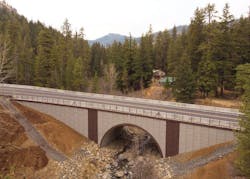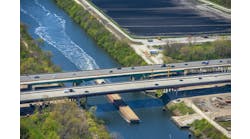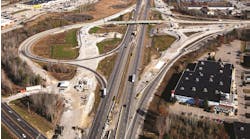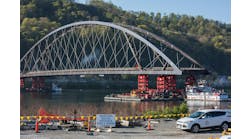Designers and contractors on a successful project are rarely as modest as those who championed the Wildcat Creek Bridge. In fact, they thought this was a pretty simple, straightforward piece of work.
“There was nothing terribly uncommon about this project,” Michael Carfagno, VP of engineering development for Contech, told Roads & Bridges. Stantec Design Manager Richard Patterson concurred, regarding specifically the creek work itself, saying, “This wasn’t a critical habitat season for the creek, so we were able to work in this limited footprint with a simple piped water run-through. It wasn’t that complicated.”
Well, complicated or not, the result is one of the best bridge builds we saw this year, and one that resulted in an enormous savings for owner Washington DOT in both time and dollars.
The original bridge was in critically poor health, and the execution of a demo and new build was a primary concern for WSDOT.
“A new bridge, yes, but also a preservation project, given the location (near Mount Rainier National Park),” Patterson told Roads & Bridges. “The existing bridge was in super bad shape. You could stand on the bridge, look through the deck and see the water; or you could be down at the water and see cars going by through the deck.”
Arches tend to hold up better in areas of seismic concern. This bridge was designed as a twin-leaf arch, meaning the concrete arch was precast in dual interlocking segments and shipped to the site for assembly. Arches offer less stress in the members and are internally braced, thus a reduced propensity for cracking and subsequent moisture intrusion.
“WSDOT initially called for a 150-ft single span I-girder bridge,” Carfagno said. “But with the Stantec team, we revised the recommendation. Experience has shown buried structures tend to do quite well in earthquakes, so this design worked for WSDOT’s requirements. Because of the span and rise—it is a 64-ft span with a 26-ft 4-in. vertical rise—we split the arch segments into two halves, with a tongue-in-groove joint to align the pieces together.”
Every project has a speed bump, and it was here that this project faced its own.
“Unfortunately, the fabricator made too many groove units, so we had to improvise a bit,” Carfagno said. “We made a tongue out of plywood, and were able to make it work. No big deal, always a hiccup during any construction project. It didn’t impact the schedule at all.”
And schedule, for the most part, was everything.
“WSDOT wanted work done by October,” Patterson said, “before weather made construction too difficult. They needed something fast. There would be a detour and full closure, so we knew we needed a solution that was fast, and that kept us away from a lot of cast-in-place work; we couldn’t wait the week to 10 days for concrete to cure. So we went with precast. Precast arch structure, precast MSE wall panels, and the rest was demo of the original bridge, excavation, installs, and backfill. That way we could build in cure time for the bridge deck itself.”
This decision ultimately reduced what would have been a four- to five-month construction schedule to just 17 days.
“As a design-build, we completely changed the basis of design from the RFP drawings, and the overall timeline from design through construction was extremely fast-paced,” Thrall Hershberger, construction manager for Graham Contractors, told R&B. “We were able to prioritize the design of the long-lead item materials, such as the arch itself and the MSE panels, and began fabrication at-risk in order to meet the accelerated schedule. With the full closure, there were schedule limitations due to summer activites in the mountains and the White Pass Ski Resort area, as well as the national forest.”
There was also a month-long delay due to a local forest fire, which precluded use of the planned detour route.
“That happened at the 11th hour,” Hershberger said. “It was within a week of the pending road closure schedule. Equipment, materials, and manpower were already coordinated down to the shift, and they had to be rescheduled.”
Nonetheless, once the threat was quashed, Graham was able to reapply its construction plan in short order.
“We self-performed 85% of the construction work,” Hershberger said, “and that benefited the rescheduling. We subbed out paving and demolition of the original structure and other things, of course.”
When all was said and done, contractors were able to meet the 17-day closure limit—including paving time—before the dense winter mountain weather moved in, and as a result saved WSDOT $4 million in the bargain.



